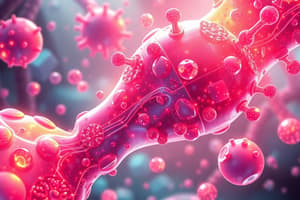Podcast
Questions and Answers
What is the end point of an anesthetic act?
What is the end point of an anesthetic act?
- Wakefulness
- Sleep (correct)
- Consciousness
- Drowsiness
In the two-compartment model of general anesthetics, what does the central compartment represent?
In the two-compartment model of general anesthetics, what does the central compartment represent?
- The CNS
- The biophase (correct)
- The rest of the body
- The effect compartment
Why is a two-compartment model used despite not knowing rate constants for most general anesthetics?
Why is a two-compartment model used despite not knowing rate constants for most general anesthetics?
- Difficulties in CNS drug concentration examination in humans (correct)
- Due to CNS concentration being easily measurable in humans
- Because of high molecular weight of general anesthetics
- High metabolism rate of general anesthetics
How do general anesthetics often leave the body?
How do general anesthetics often leave the body?
What characteristic makes it challenging to determine rate constants for most general anesthetics?
What characteristic makes it challenging to determine rate constants for most general anesthetics?
Which compartment in the two-compartment model represents the rest of the body?
Which compartment in the two-compartment model represents the rest of the body?
Which type of drug elimination is primarily affected by a reduction in blood flow to the liver or liver disease?
Which type of drug elimination is primarily affected by a reduction in blood flow to the liver or liver disease?
In which metabolism phase are drugs usually chemically altered in the liver and/or conjugated with glucuronic acid or sulphate for 'capacity-limited' elimination?
In which metabolism phase are drugs usually chemically altered in the liver and/or conjugated with glucuronic acid or sulphate for 'capacity-limited' elimination?
What type of circulation does high lipid solubility favor, contributing to a prolonged duration of action of drugs?
What type of circulation does high lipid solubility favor, contributing to a prolonged duration of action of drugs?
Which factor can cause delayed recovery from anesthesia in the post-operative period related to volatile agents or their metabolites?
Which factor can cause delayed recovery from anesthesia in the post-operative period related to volatile agents or their metabolites?
What distinguishes drugs exhibiting 'flow-limited' elimination from those exhibiting 'capacity-limited' elimination?
What distinguishes drugs exhibiting 'flow-limited' elimination from those exhibiting 'capacity-limited' elimination?
Which factor influences the absorption of an inhaled anesthetic the most?
Which factor influences the absorption of an inhaled anesthetic the most?
What contributes to the rapid distribution of anesthesia to the brain, heart, kidney, and liver?
What contributes to the rapid distribution of anesthesia to the brain, heart, kidney, and liver?
Which organ is mentioned as being less perfused and therefore having less anesthetic during distribution?
Which organ is mentioned as being less perfused and therefore having less anesthetic during distribution?
What process terminates CNS effects by moving the drug from the site of action to other tissues?
What process terminates CNS effects by moving the drug from the site of action to other tissues?
Which type of metabolism can produce toxic metabolites among inhaled anesthetics?
Which type of metabolism can produce toxic metabolites among inhaled anesthetics?
Which intravenous anesthetic is processed through hydrolysis of the imidazole double bond for subsequent metabolism to inactive metabolites?
Which intravenous anesthetic is processed through hydrolysis of the imidazole double bond for subsequent metabolism to inactive metabolites?
Which general anesthetic can result in hepatotoxicity due to oxidative metabolism by the hepatic p450 enzyme system?
Which general anesthetic can result in hepatotoxicity due to oxidative metabolism by the hepatic p450 enzyme system?
Which organ system plays a crucial role in facilitating fast drug recovery by conjugating intravenous anesthetics to inactive water-soluble metabolites?
Which organ system plays a crucial role in facilitating fast drug recovery by conjugating intravenous anesthetics to inactive water-soluble metabolites?
Which aspect of general anesthetics facilitates their elimination through the lungs?
Which aspect of general anesthetics facilitates their elimination through the lungs?
Flashcards are hidden until you start studying




